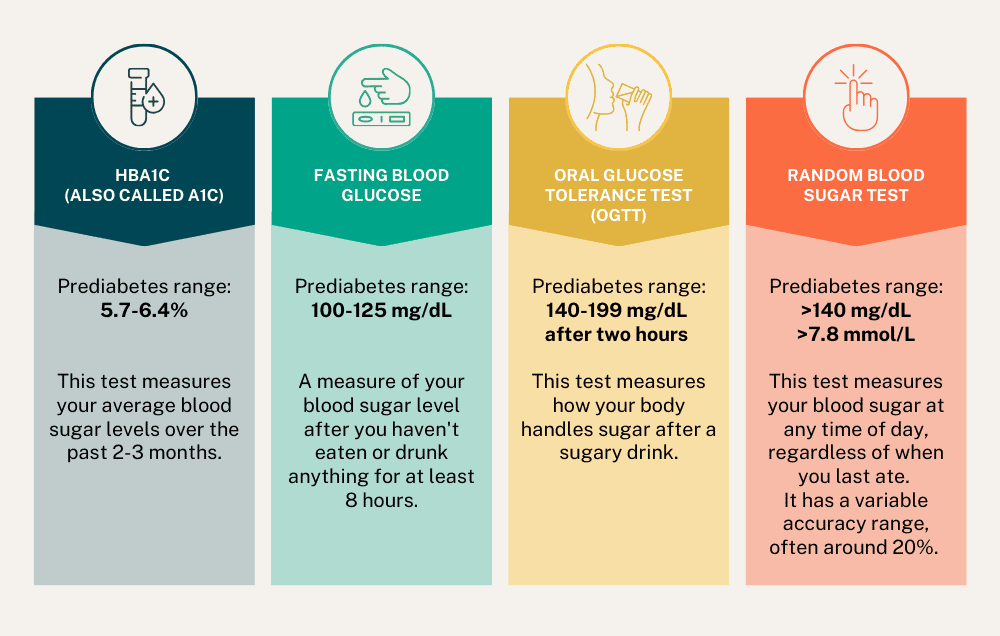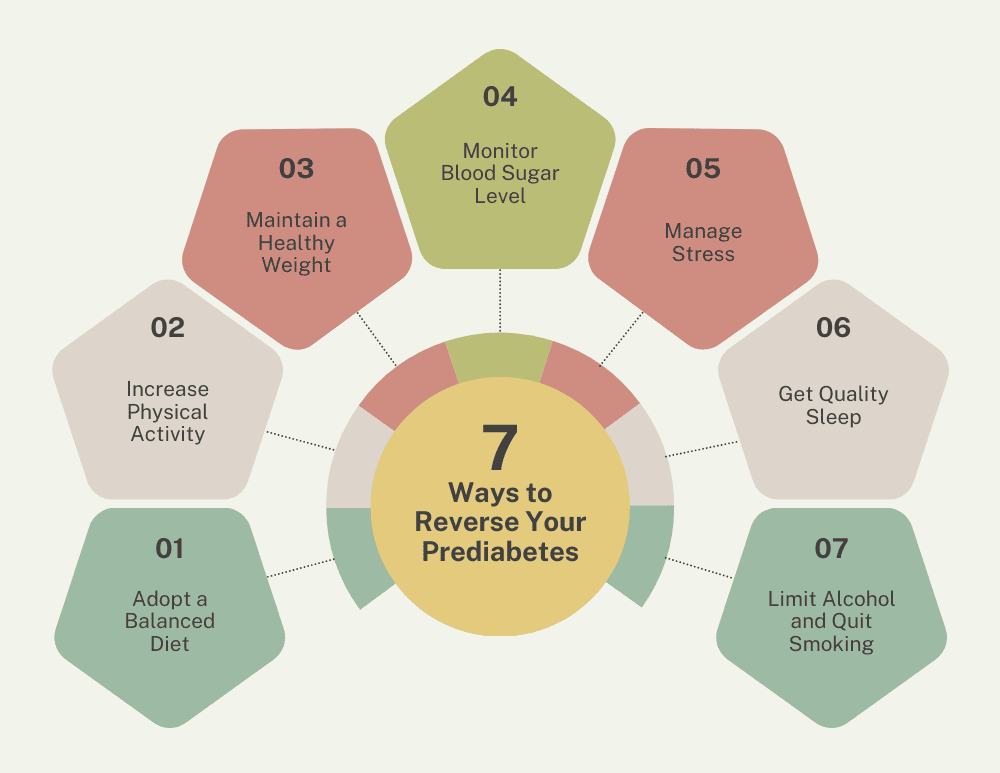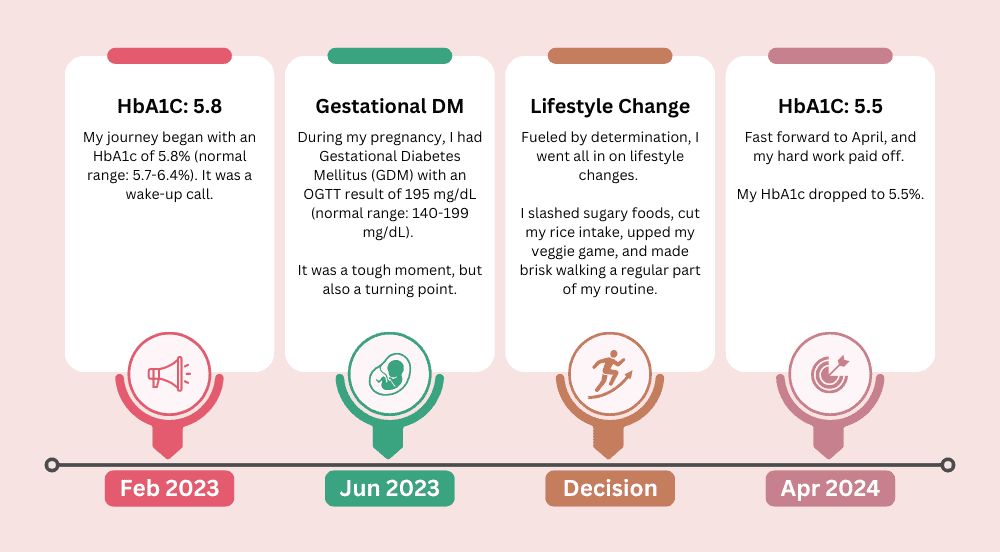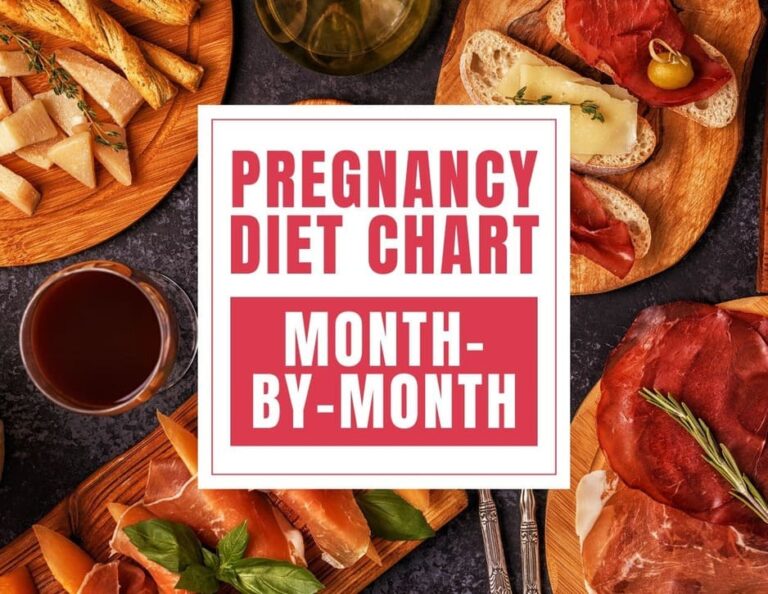What is Prediabetes? How I Reverse Prediabetes in 1 Year
This post may contain affiliate links. That means if you click and buy, I may receive a small commission (at zero cost to you). Please see my full disclosure policy for more details.
2023 was a whirlwind year for me, and not just because I had a second little one on the way.

I remember sitting in the doctor’s office, casually expecting my routine check-up to go as usual—until my HbA1c came back at 5.8!
Yep, I was OFFICIALLY in the prediabetes zone.
And if that wasn’t enough, just a few months later, I was diagnosed with gestational diabetes during my pregnancy. Talk about a WAKE-UP CALL!
As a pharmacist, I thought I had a handle on what all this meant, but it’s a whole different ballgame when it’s happening to you.
Suddenly, the facts and figures took on a personal meaning, and I knew I had to get serious about my health—not just for me, but for my growing family.
Approximately 1 in 3 adults worldwide have prediabetes.
(source)
If you’ve ever wondered what prediabetes is or how to stop it from turning into something more serious, you’re in the right place.
What is Prediabetes?
Prediabetes is a condition where your blood sugar levels are higher than normal but not yet high enough to be classified as Type 2 diabetes.
In simple terms, prediabetes means that your body is starting to struggle with processing sugar, but it hasn’t reached the critical point of diabetes yet.
The main culprit behind this condition is INSULIN RESISTANCE, where your cells aren’t responding as well to insulin, a hormone that helps manage blood sugar levels.
This leads to a buildup of glucose in your bloodstream, which, if left unchecked, can progress to Type 2 diabetes.
CAUTION: 50% of people with prediabetes will develop type 2 diabetes within 5-10 years if left untreated.
(source)
Is Prediabetes Very Serious?
Absolutely YES, if you let it be.
While prediabetes itself isn’t diabetes, it shouldn’t be ignored.
It means your body is already having trouble managing blood sugar, which can lead to more severe health issues if not addressed.
Think of it as a warning sign from your body, letting you know that your glucose metabolism isn’t quite where it should be.

It’s like a yellow traffic light—caution is needed, but there’s still time to take action before it turns red.
Diagnosis of Prediabetes
To diagnose prediabetes, doctors look at specific blood sugar tests. The most common are:

A single most commonly asked question:
I just tested my blood sugar level and I am concerned, it was [x] reading. Am I in trouble / diabetic / pre-diabetic?
The answer: One blood sugar reading alone isn’t enough to determine if you’re diabetic or pre-diabetic.
To get a clear diagnosis, healthcare pros rely on a series of tests. These tests give a more complete picture of how your body is managing blood sugar over time, helping to pinpoint any issues.
Does Prediabetes Go Away?
Absolutely! Prediabetes is reversible. Like I did!
With lifestyle changes—like healthier eating, more exercise, and weight management—you can bring your blood sugar back to normal and lower your risk of developing Type 2 diabetes.
CAUTION: Even if you manage to reverse prediabetes, it’s important to know that the risk of developing it again is higher than for those who’ve never had it.
This is not an “UNDO-AND-FORGET” situation. I wish it is!
Maintaining these lifestyle changes is crucial to keeping your blood sugar levels in check and reducing the risk of prediabetes coming back.
Risk Factors for Prediabetes
- Family History:
- If you have a parent or sibling with Type 2 diabetes, your risk of prediabetes will be 2-6 times more.
- Age:
- The risk of prediabetes increases as you age, particularly after the age of 45.
- Over half of adults aged 65 and older have the condition.
- Weight:
- Over 80% of individuals with prediabetes are overweight or obese. Excess fat, especially around the abdomen, increases insulin resistance.
- Physical Inactivity:
- A lack of regular physical activity contributes to weight gain and increases insulin resistance, raising the risk of prediabetes.
- Diet:
- A diet high in refined carbs, sugary foods, and unhealthy fats can lead to weight gain and insulin resistance.
- Gestational Diabetes:
- If you developed gestational diabetes during pregnancy, your risk of prediabetes is higher.
- Polycystic Ovary Syndrome (PCOS):
- Women with PCOS, a hormonal disorder, have an increased risk of insulin resistance and prediabetes.
- Sleep Disorders:
- Sleep issues like sleep apnea can disrupt the balance of insulin and glucose, increasing the risk of prediabetes.
- High Blood Pressure:
- Having high blood pressure is often associated with insulin resistance, leading to a higher risk of prediabetes.
- Ethnicity:
- Certain ethnic groups, including African Americans, Hispanics, Native Americans, and Asian Americans, are at higher risk of developing prediabetes.
In my case, irregular physical activity, a diet influenced by living in Malaysia—a place known for its high-carb foods (like rice, noodle and pastry)—and an occasional love for sweet treats have all contributed to my risk.
Additionally, my experience with gestational diabetes during my second pregnancy has put me at a higher risk for prediabetes.
I know someone who developed Type 2 diabetes just 5 years after having gestational diabetes because they didn’t make any lifestyle changes.
Recognizing these factors can be crucial in making informed decisions about your health and taking proactive steps to manage your risk.
Signs and Symptoms
I personally didn’t experience any noticeable prediabetes symptoms.
Had I not had the health awareness to do my annual check-up in 2023, I might be greeted with a diagnosis of Type 2 diabetes instead.
Do you know?
STATISTICS: About 80% of people with prediabetes don’t know they have it, because it often doesn’t present obvious symptoms.
(source)
But here are some subtle signs that might give you a clue:
- Increased Thirst: That’s your body’s way of trying to get rid of excess glucose by making you drink more.
- Frequent Urination: Your body is working overtime to flush out the extra sugar.
- Fatigue: Your body could be struggling to manage your blood sugar levels, leading to that relentless fatigue.
- Blurred Vision: High blood sugar levels might be affecting your eye’s lens.
- Slow-Healing Wounds: High blood sugar can impact your body’s natural healing process.
- Dark Patches on Skin: This could be a sign of insulin resistance.
Health Complications of Prediabetes
Prediabetes isn’t just a temporary concern; it carries significant health implications if left unmanaged.
Here’s what you need to know:
- Progression to Type 2 Diabetes:
- Approximately 50% of people with prediabetes will develop type 2 diabetes within 5-10 years if left untreated.
- Increased Risk of Cardiovascular Disease:
- People with diabetes have a 2-4 times higher risk of heart disease compared to those with normal blood sugar levels.
- Higher Risk of Stroke:
- Elevated blood sugar levels can contribute to inflammation and damage to blood vessels, increasing the likelihood of stroke.
- Potential for Weight Gain:
- Insulin resistance often leads to weight gain, especially around the abdomen, which further exacerbates blood sugar issues and increases the risk of other health problems.
- Impaired Immune Function:
- High blood sugar can impair your immune system, making it harder for your body to fight off infections and heal wounds.
- Impact on Mental Health:
- The stress of managing a chronic condition like prediabetes can affect your mental health, potentially leading to anxiety and depression.
- Skin Changes:
- Prediabetes can cause skin changes, such as dark, velvety patches, particularly around the neck or armpits, which can be a sign of insulin resistance.
Is Prediabetes very serious?
Absolutely YESSSSS – if you let it be!
How do You Fix Prediabetes?
After my diagnosis, my first goal was to follow THE BALANCED PLATE METHOD.

The plate method is a simple way to balance your meals by filling half your plate with non-starchy vegetables, a quarter with lean protein, and the other quarter with whole grains or starchy vegetables. I cut down my carbs and increased my intake of protein and fiber.
This was tough for me because I absolutely love pasta and caramel popcorn!
Learn more: Glycemic Index of 650+ Foods (with Free Printable!)
As a working mom with two daughters, my schedule is hectic, and exercise was never a priority.
But now, I make it a point to squeeze in 30 minutes of brisk walking, five days a week.
Is it easy? No. But it is doable!
These initial changes helped me take control of my health and set a strong foundation for managing prediabetes effectively.

- Adopt a Balanced Diet:
- Eat more vegetables, fruits, whole grains, lean proteins, and healthy fats while cutting back on refined carbs and sugary snacks.
- If you love white rice too like me, you can learn more about there sugar-friendly alternatives to white rice.
- Increase Physical Activity:
- Exercise moderately (such as brisk walking) 30 minutes a day, five days a week can lower your risk for type 2 diabetes by 58%.
- Maintain a Healthy Weight:
- Losing even 7% of your body weight can lower your risk for type 2 diabetes by 58%.
- Monitor Your Blood Sugar Levels:
- Have your blood sugar levels checked at least once a year if you have prediabetes. Your doctor may recommend more frequent checks based on your health.
- Manage Stress:
- Use stress-management techniques such as mindfulness or yoga to help keep your blood sugar levels in check.
- Get Quality Sleep:
- Aim for 7-9 hours of quality sleep each night to support insulin sensitivity.
- Limit Alcohol and Quit Smoking:
- Reducing alcohol intake and quitting smoking can help improve overall health and lower risk.
Medical Treatment for Prediabetes
While I manage my prediabetes without medications, some people with higher risk factors may need additional medical help:
- Metformin (MOST COMMON):
- Mechanism of action: Increases insulin sensitivity and reduces glucose production by the liver.
- Benefits: Can help lower blood sugar levels and reduce the risk of developing type 2 diabetes.
- Thiazolidinediones (TZDs):
- Mechanism of action: Improve insulin sensitivity in muscle and fat cells.
- Benefits: Can help lower blood sugar levels and reduce the risk of heart disease.
- Sodium-glucose cotransporter-2 (SGLT2) inhibitors:
- Mechanism of action: Promote glucose excretion in the urine.
- Benefits: Can help lower blood sugar levels and reduce the risk of heart failure.
- Glucagon-like peptide-1 (GLP-1) receptor agonists:
- Mechanism of action: Slow down the emptying of the stomach, increase insulin production, and decrease glucagon production.
- Benefits: Can help lower blood sugar levels, promote weight loss, and reduce the risk of heart disease.
The best treatment for prediabetes is all about finding what works best for you, and it’s often most effective when paired with lifestyle changes.
Regular check-ins with your healthcare provider are crucial to customize your approach and stay on top of managing prediabetes.
SAD TRUTH: A whopping 77.9% of adults with diabetes take five or more medications, and 17.2% manage 10 or more.
(source)
Just don’t advance to diabetes!
Real-Life Success Story: How I Reverse My Prediabetes
Here’s a peek into my personal journey with prediabetes:

Does prediabetes go away? YES IT DID!
My story is proof that with commitment and the right lifestyle tweaks, you can make real progress. If I can do it, so can you!
Conclusion
When I was first diagnosed with prediabetes, I was devastated—I even shed tears.
I’ve always considered myself very health-conscious, so it came as a shock not just to me, but to everyone around me.
People were surprised, knowing that I’m lean and always mindful of my sugar intake.
But it is what it is. I decided to pick myself up, face the reality, and take action. I started making changes, and it’s been a journey of learning and adapting ever since.
It’s never too late to make a difference in your health. Keep pushing forward—you’ve got this!
I’d love to hear about your journey—how are you managing prediabetes? Share your story in the comments below, and let’s support and inspire each other!






